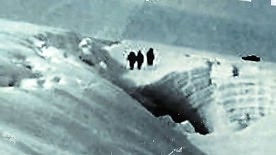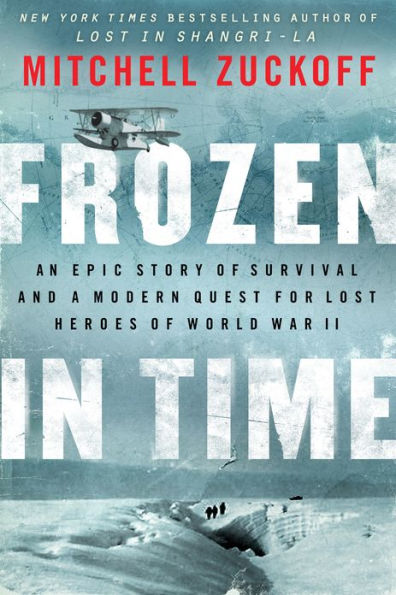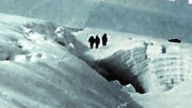Read an Excerpt
Frozen in Time
By Mitchell Zuckoff HarperCollins Publishers
Copyright © 2013 Mitchell Zuckoff
All rights reserved.
ISBN: 978-0-06-213343-4
1
G R E E N L A N D
2 0 0 0 BC TO AD 19 42
GREENLAND MAKES NO sense.
First there's the name, which as most schoolchildren know
should be Iceland, but that was already taken. Almost nothing
green grows in Greenland, where more than eighty percent of the
land is buried under deep ice. Deep, as in, up to ten thousand
feet, or two solid miles. If all of Greenland's ice melted—a worst-
case scenario of climate change—the world's oceans would rise by
twenty feet or more.
Greenland's colorful name is blamed on a colorful Viking
called Erik the Red. Erik went to sea when he was exiled from
nearby Iceland in the year 982, after he killed two men in a
neighborhood dispute. In addition to being an explorer, a fugi-
tive killer, and a lousy neighbor, Erik was the world's first real-
estate shill. He christened his discovery Greenland in the belief
that a “good name” would encourage his countrymen to settle
there with him. The ploy worked, and the community that Erik
founded on the island's southwest coast survived for more than
four centuries.
1 0 F R O Z E N I N T I M E
Unlike the Pilgrims who came to North America, Erik and
his band found no nearby natives to trade with or learn from. So
they relied on themselves and on imports from Europe. But by
the Middle Ages, decades passed between ships. The once-robust
Vikings grew smaller and weaker. Eventually they died out alto-
gether, leaving ruins but little else. Erik the Red is perhaps better
remembered for siring Leif Eriksson, who sailed to North America
some five hundred years before Columbus. Leif called his discov-
ery Vinland, or Wineland. But Icelanders wouldn't be fooled twice
by the same family, and no lasting settlements followed.
A competing but equally odd theory says that the name Green-
land was bestowed by the native Inuit people, formerly called Es-
kimos by outsiders. Their sporadic presence on Greenland traces
back some four thousand years, starting with travelers believed
to have crossed the narrow straits from North America. The Inuit
clustered near the rocky coastline and in the words of one me-
dieval historian, Adam of Bremen, had “lived there long enough
to have acquired a greenish tinge from the seawater beside which
they dwelt.” Under this theory, anyone who looked vaguely green
must have come from Greenland.
If Greenland had to be named for a color, white seems the ob-
vious choice. But blue was viable, as well. Although white at the
surface, glacier ice on much of Greenland comes in translucent
shades of blue, ranging from faint aquamarine and turquoise just
below the surface to indigo in the depths of crevasses. The phe-
nomenon is caused by countless years of snow being compacted
into ice. Snow contains oxygen, which scatters light across the vis-
ible spectrum, making it appear white. Compacting squeezes out
the oxygen, and the compacted ice crystals that remain absorb
long light waves and reflect short waves. The shortest light waves
are violet and blue. And so, the ice at the cold heart of Greenland
is blue.
G R E E N L A N D 1 1
GREENLAND'S STRANGENESS IS compounded by its great but
politically inconsequential size; its almost complete emptiness;
and its unconscionable weather.
In a world where size generally matters, Greenland's doesn't.
The island is globally overlooked despite being enormous: more
than sixteen hundred miles from north to south, and eight hun-
dred miles at its widest point. Greenland could swallow Texas
and California and still have room for a dessert of New Mexico,
Arizona, Florida, Pennsylvania, and all of New England. It's three
times the size of France, and it occupies more than twice the area
of the planet's second-largest island, New Guinea.
Yet Greenland is the world's loneliest place. With fifty-eight
thousand residents, it has the lowest population density of any
country or dependent territory. Only Antarctica, with no perma-
nent residents, makes Greenland seem crowded. If Manhattan had
the same population density as Greenland, its population would
be two.
One way to picture Greenland is to look at a world map and
find the blank white spot to the northeast of North America. An-
other way is to imagine an immense bowl filled with ice. At the
outer edge of the island, jagged mountains that rise as high as
twelve thousand feet create the bowl's rim. The land between the
coastal mountains, the bowl's concave middle, is filled with ice
that built up over tens of thousands of years, as yearly snowfall
exceeded melting. The more the ice accumulated, the more the
land in the central part of the island became depressed from the
weight. Hence the ice-filled bowl that is Greenland.
A closer look reveals that the bowl's rim has cracks—spaces
between the mountains. Driven by gravity, large bodies of ice
called glaciers flow toward the sea like slow-moving rivers.
When a glacier's leading edge runs out of land, it fulfills its des-
tiny by hurling itself piece by piece into the water. The process,
1 2 F R O Z E N I N T I M E
called calving, is loud and violent and magnificent. Big pieces of
glaciers are reborn as icebergs, some big enough to sink an un-
sinkable ship. In summer 2012, a glacier in northwest Greenland
gave birth to an iceberg the size of Boston. The smallest icebergs
are known to Coast Guardsmen as “growlers” because they make
sounds like snarling animals when trapped air escapes from in-
side.
Most photographs of Greenland's glaciers and their iceberg off-
spring fail to capture their grandeur. They look on film like frothy
meringue in a cookbook. In reality, they are unstoppable giants
that have conquered the world multiple times, and they wouldn't
hesitate to unleash a new ice age if given the chance.
Although the bowl-of-ice analogy
(Continues...)
Excerpted from Frozen in Time by Mitchell Zuckoff. Copyright © 2013 Mitchell Zuckoff. Excerpted by permission of HarperCollins Publishers.
All rights reserved. No part of this excerpt may be reproduced or reprinted without permission in writing from the publisher.
Excerpts are provided by Dial-A-Book Inc. solely for the personal use of visitors to this web site.






